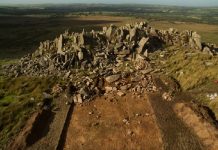New discoveries shed light on Stonehenge mysteries

Geologists have long known that 42 of Stonehenge’s smaller stones, known as bluestones, came from the Preseli hills in Pembrokeshire, in western Wales. Now a new study published in Antiquity pinpoints the locations of two of these quarries and hypothesises on when and how the stones were quarried.
A team of archaeologists and geologists have been investigating the site for eight years and their findings provide clues to one of Stonehenge’s biggest mysteries: why were its stones brought from so far away?
“Every other Neolithic monument in Europe was built of megaliths brought from no more than 10 miles [(16km] away,” Professor Mike Parker Pearson, from University College London’s (UCL) archaeology department and the team leader, said. “We’re now looking to find out just what was so special about the Preseli hills 5000 years ago, and whether there were any important stone circles here, built before the bluestones were moved to Stonehenge.”
According to the new study, the bluestone outcrops are formed of natural, vertical pillars. These could be eased off the rock face by opening up the vertical joints between each pillar. Unlike stone quarries in ancient Egypt, where obelisks were carved out of the solid rock, the Welsh quarries were easier to exploit.
Neolithic quarry workers needed only to insert wedges into the ready-made joints between pillars, then lower each pillar to the foot of the outcrop. Although most of their equipment is likely to have consisted of perishable ropes and wooden wedges, mallets and levers, they left behind other tools such as hammer stones and stone wedges.
“The stone wedges are made of imported mudstone, much softer than the hard dolerite pillars,” Parker Pearson said. “An engineering colleague has suggested that hammering in a hard wedge could have created stress fractures, causing the thin pillars to crack. Using a soft wedge means that, if anything were to break, it would be the wedge and not the pillar.”
Transporting the bluestone
The largest quarry was found almost 290km away from Stonehenge, on the outcrop of Carn Goedog, on the north slope of the Preseli hills.
“This was the dominant source of Stonehenge’s spotted dolerite, so-called because it has white spots in the igneous blue rock,” Dr Richard Bevins, a National Museum of Wales geologist, said. “At least five of Stonehenge’s bluestones, and probably more, came from Carn Goedog.”
In the soft sediment of a hollowed-out track leading from the loading bay at Craig Rhos-y-felin, and on the artificial platform at Carn Goedog, the team recovered pieces of charcoal dating to about 3000 BC. They now think that Stonehenge was initially a circle of rough, unworked bluestone pillars set in nearby pits known as the Aubrey Holes, and that the sarsens (sandstone blocks) were added some 500 years later.
The new discoveries also cast doubt on a popular theory that the bluestones were transported by sea to Stonehenge.
“Some people think that the bluestones were taken southwards to Milford Haven and placed on rafts or slung between boats and then paddled up the Bristol Channel and along the Bristol Avon towards Salisbury Plain,” Professor Kate Welham from Bournemouth University said. “But these quarries are on the north side of the Preseli hills so the megaliths could have simply gone overland all the way to Salisbury Plain.”
Source: www.quarrymagazine.com
The post New discoveries shed light on Stonehenge mysteries appeared first on StoneNews.eu.
4:41 am May 25, 2020

Atieh Pasargad Amethyst International Trade Company ( سنگ پاسارگاد )
Address: Old Qom kashan Road – Omid Stone City – Qom – Iran
Email:
Ali Shafiei – CMO » Ali@pasargadstone.com
Hossein Shafiei – CEO » Hossein@pasargadstone.com
(+98) 912 553 5362
Ali Shafiei – CMO
Chief Marketing Officer
(+98) 912 251 8055
Hossein Shafiei – CEO
Chief Executive Officer
سنگ پاسارگاد – Pasargad Stone All Right Reserved
Designed and Developed by Branex.ir برانکس
